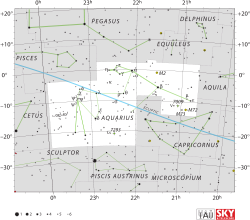Delta Aquarii
| Observation data Epoch J2000 Equinox J2000 | |
|---|---|
| Constellation | Aquarius |
| Right ascension | 22h 54m 39.0125s[1] |
| Declination | −15° 49′ 14.953″[1] |
| Apparent magnitude (V) | 3.252[2] |
| Characteristics | |
| Spectral type | A3 V[3] |
| U−B color index | +0.172[2] |
| B−V color index | +0.068[2] |
| Astrometry | |
| Radial velocity (Rv) | +18.0[4] km/s |
| Proper motion (μ) | RA: -42.60[1] mas/yr Dec.: -27.89[1] mas/yr |
| Parallax (π) | 20.44 ± 2.26 mas[1] |
| Distance | approx. 160 ly (approx. 49 pc) |
| Details | |
| Mass | 2.0[5] M☉ |
| Radius | 2.4[5] R☉ |
| Luminosity | 26[5] L☉ |
| Surface gravity (log g) | 3.66[6] cgs |
| Temperature | 9,000[6] K |
| Metallicity [Fe/H] | –0.15[6] dex |
| Rotational velocity (v sin i) | 81[7] km/s |
| Age | 0.3[8] Gyr |
| Other designations | |
| Database references | |
| SIMBAD | data |
Delta Aquarii (δ Aqr, δ Aquarii) is the third-brightest star in the constellation Aquarius. It has the traditional name Skat,[10] which has also been used for Beta Pegasi. The apparent visual magnitude is 3.3,[2] which can be seen with the naked eye. The distance to this star is estimated as 160 light-years (49 parsecs) based upon parallax measurements.[1]
Properties
The spectrum of Skat matches a stellar classification of A3 V,[3] indicating this is an A-type main sequence star that is generating energy through the nuclear fusion of hydrogen at its core. This star has double the Sun's mass and a radius 2.4 times as large.[5] It is radiating 26[5] times the luminosity of the Sun from its outer atmosphere at an effective temperature of around 9,000 K.[6] This heat gives it the characteristic white-hued glow of an A-type star.[11] It has a relatively high rate of rotation, with a projected rotational velocity of 81 km s−1.[7]
Delta Aquarii has been closely examined for a companion, but none has been discovered.[8] Nor does it display a strong signal of excess infrared emission that might indicate the presence of circumstellar matter.[12] Delta Aquarii is a probable stream star member of the Ursa Major Moving Group,[13] which has an estimated age of 500 million years.[14]
In culture
The traditional name has generally been thought to derive from the Arabic as-saq (الساق) "leg" or "shin"; however, the medieval forms Scheat, Seat, Sheat suggest it may be instead from the Arabic ši'at (شئت) "wish".[1]
In Chinese, 羽林軍 (Yǔ Lín Jūn), meaning Palace Guard, refers to an asterism consisting of δ Aquarii, 29 Aquarii, 35 Aquarii, 41 Aquarii, 47 Aquarii, 49 Aquarii, λ Piscis Austrini, HD 212448, ε Piscis Austrini, 21 Piscis Austrini, 20 Piscis Austrini, υ Aquarii, 68 Aquarii, 66 Aquarii, 61 Aquarii, 53 Aquarii, 50 Aquarii, 56 Aquarii, 45 Aquarii, 58 Aquarii, 64 Aquarii, 65 Aquarii, 70 Aquarii, 74 Aquarii, τ2 Aquarii, τ1 Aquarii, 77 Aquarii, 88 Aquarii, 89 Aquarii, 86 Aquarii, 101 Aquarii, 100 Aquarii, 99 Aquarii, 98 Aquarii, 97 Aquarii, 94 Aquarii, ψ3Aquarii, ψ2Aquarii, ψ1Aquarii, 87 Aquarii, 85 Aquarii, 83 Aquarii, χ Aquarii, ω1 Aquarii and ω2 Aquarii. Consequently, δ Aquarii itself is known as 羽林軍二十六 (Yǔ Lín Jūn ershíliù, Template:Lang-en.)[15]
References
- ^ a b c d e f van Leeuwen, F. (November 2007), "Validation of the new Hipparcos reduction", Astronomy and Astrophysics, 474 (2): 653–664, arXiv:0708.1752, Bibcode:2007A&A...474..653V, doi:10.1051/0004-6361:20078357
- ^ a b c d Celis S., L. (October 1975), "Photoelectric photometry of late-type variable stars", Astronomy and Astrophysics Supplement Series, 22: 9–17, Bibcode:1975A&AS...22....9C
- ^ a b Houk, Nancy (1979), Michigan catalogue of two-dimensional spectral types for the HD stars, vol. 4, Ann Arbor, Michigan: Dept. of Astronomy, University of Michigan, Bibcode:1988MSS...C04....0H
- ^ Wilson, Ralph Elmer (1953). General Catalogue of Stellar Radial Velocities. Washington: Carnegie Institution of Washington. Bibcode:1953QB901.W495.....
- ^ a b c d e Malagnini, M. L.; Morossi, C. (November 1990), "Accurate absolute luminosities, effective temperatures, radii, masses and surface gravities for a selected sample of field stars", Astronomy and Astrophysics Supplement Series, 85 (3): 1015–1019, Bibcode:1990A&AS...85.1015M
- ^ a b c d Hill, G. M. (February 1995), "Compositional differences among the A-type stars. 2: Spectrum synthesis up to V sin i = 110 km/s", Astronomy and Astrophysics, 294 (2): 536–546, Bibcode:1995A&A...294..536H
- ^ a b Royer, F.; Zorec, J.; Gómez, A. E. (February 2007), "Rotational velocities of A-type stars. III. Velocity distributions", Astronomy and Astrophysics, 463 (2): 671–682, arXiv:astro-ph/0610785, Bibcode:2007A&A...463..671R, doi:10.1051/0004-6361:20065224
- ^ a b Ehrenreich, D.; et al. (November 2010), "Deep infrared imaging of close companions to austral A- and F-type stars", Astronomy and Astrophysics, 523: A73, arXiv:1007.0002, Bibcode:2010A&A...523A..73E, doi:10.1051/0004-6361/201014763
- ^ "del Aqr -- Star", SIMBAD, Centre de Données astronomiques de Strasbourg, retrieved 2012-01-30
- ^ Allen, Richard Hinkley (1963), Star Names: Their Lore and Meaning, New York: Dover Publications, ISBN 0-486-21079-0
- ^ "The Colour of Stars", Australia Telescope, Outreach and Education, Commonwealth Scientific and Industrial Research Organisation, December 21, 2004, retrieved 2012-01-16
- ^ Su, K. Y. L.; et al. (December 2006), "Debris Disk Evolution around A Stars", The Astrophysical Journal, 653 (1): 675–689, arXiv:astro-ph/0608563, Bibcode:2006ApJ...653..675S, doi:10.1086/508649
- ^ King, Jeremy R.; et al. (April 2003), "Stellar Kinematic Groups. II. A Reexamination of the Membership, Activity, and Age of the Ursa Major Group", The Astronomical Journal, 125 (4): 1980–2017, Bibcode:2003AJ....125.1980K, doi:10.1086/368241
- ^ Monier, R. (November 2005), "Abundances of a sample of A and F-type dwarf members of the Ursa Major Group", Astronomy and Astrophysics, 442 (2): 563–566, Bibcode:2005A&A...442..563M, doi:10.1051/0004-6361:20053222
- ^ Template:Zh icon AEEA (Activities of Exhibition and Education in Astronomy) 天文教育資訊網 2006 年 7 月 7 日

